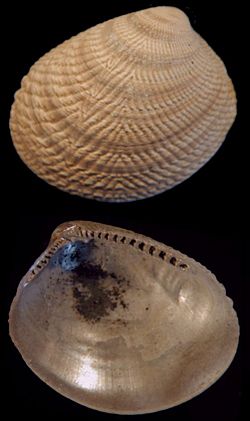| Protobranchia | |
|---|---|
 | |
| Two views of a left valve of Acila cobboldiae from the early Pleistocene of the Netherlands | |
| Scientific classification | |
| Domain: | Eukaryota |
| Kingdom: | Animalia |
| Phylum: | Mollusca |
| Class: | Bivalvia |
| Subclass: | Protobranchia Pelseneer, 1889 |
| Orders | |
| Synonyms | |
Palaeotaxodonta | |
Protobranchia is a subclass of bivalve molluscs. [1] It contains the extant orders Nuculanida, Nuculida, and Solemyida.
Contents
These are deep water clams of a small and primitive order with a taxodont hinge (composed of many similar, small teeth), generally with a central ligament pit, large labial palps which are used in deposit feeding and the gills used only for respiration, the anterior and posterior adductor muscles are nearly equal in size, a foot which is divided sagittally and longitudinally with papillate margins. The foot in Protobranchia clams is without a true byssus gland, although they frequently have a nonhomologous byssal gland in the heel. The byssal gland in these clams does not produce threads as in Pteriomorphia. [2]